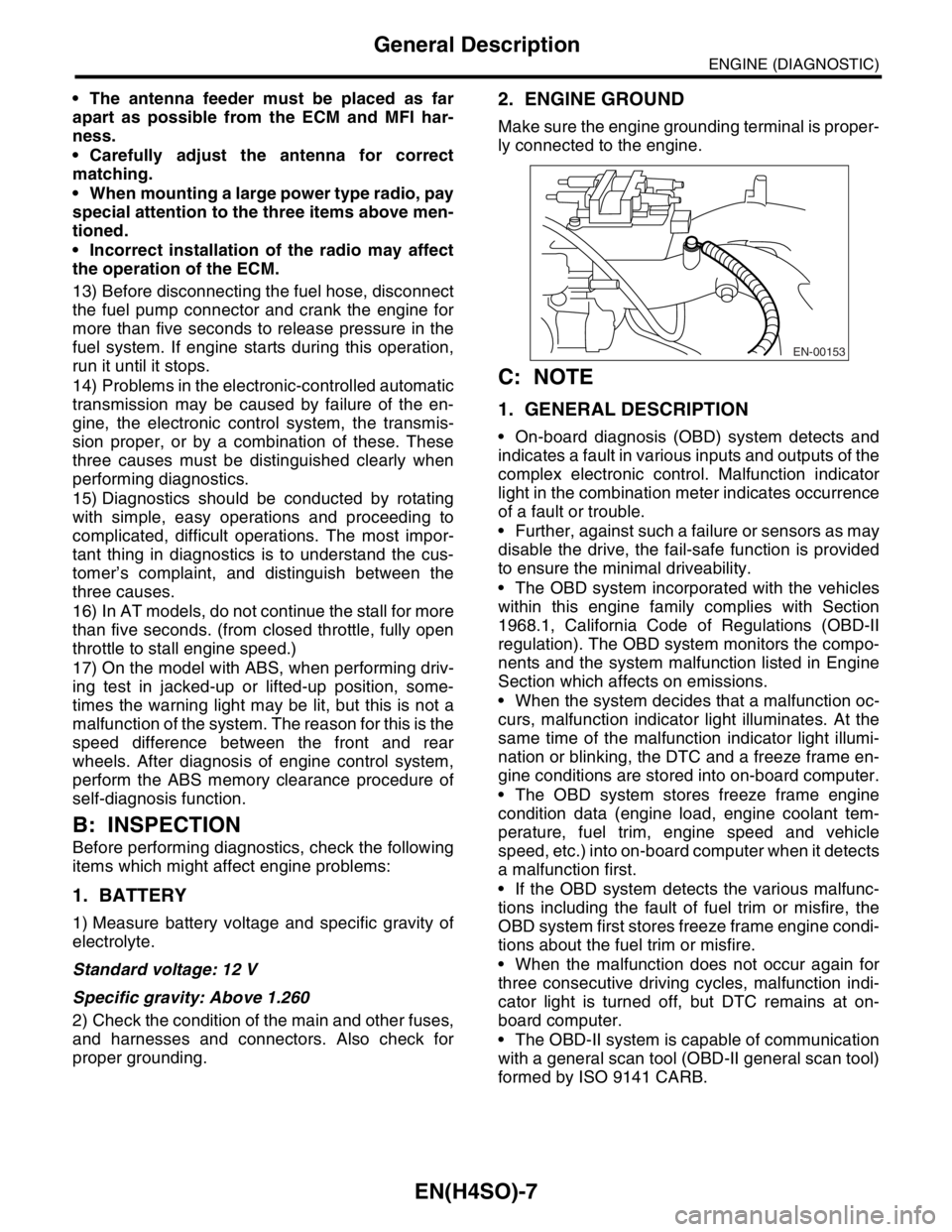Page 1102 of 2870

EN(H4SO)-4
ENGINE (DIAGNOSTIC)
Check List for Interview
2. Check List for Interview
A: INSPECTION
1. CHECK LIST No. 1
Check the following items when problem has occurred.
NOTE:
Use copies of this page for interviewing customers.
Customer’s name Engine No.
Date of sale Fuel brand
Date of repair
Odometer readingkm
V.I.N.miles
Weather❏ Fine
❏ Cloudy
❏ Rainy
❏ Snowy
❏ Va r i o u s / O t h e r s :
Ambient air temperature°C (°F)
❏ Hot
❏ War m
❏ Cool
❏ Cold
Place❏ Highway
❏ Suburbs
❏ Inner city
❏ Uphill
❏ Downhill
❏ Rough road
❏ Others:
Engine temperature❏ Cold
❏ War ming-up
❏ After warming-up
❏ Any temperature
❏ Others:
Engine speed rpm
Vehicle speed km/h (MPH)
Driving conditions❏ Not affected
❏ At starting
❏ While idling
❏ At racing
❏ While accelerating
❏ While cruising
❏ While decelerating
❏ While turning (RH/LH)
Headlight❏ ON / ❏ OFF Rear defogger❏ ON / ❏ OFF
Blower❏ ON / ❏ OFF Audio❏ ON / ❏ OFF
A/C compressor❏ ON / ❏ OFF Car phone❏ ON / ❏ OFF
Radiator fan❏ ON / ❏ OFF
Fr o nt wi pe r❏ ON / ❏ OFF
Rear wiper❏ ON / ❏ OFF
Page 1103 of 2870

EN(H4SO)-5
ENGINE (DIAGNOSTIC)
Check List for Interview
2. CHECK LIST No. 2
Check the following items about the vehicle’s state when malfunction indicator light turns on.
NOTE:
Use copies of this page for interviewing customers.
a) Other warning lights or indicators turn on. ❏ Yes / ❏ No
❏ Low fuel warning light
❏ Charge indicator light
❏ AT diagnostic indicator light
❏ ABS Warning light
❏ Oil pressure indicator light
b) Fuel level
Lack of gasoline: ❏ Yes / ❏ No
Indicator position of fuel gauge:
Experienced running out of fuel: ❏ Ye s / ❏ No
c) Intentional connecting or disconnecting of harness connectors or spark plug cords: ❏ Yes / ❏ No
What:
d) Intentional connecting or disconnecting of hoses: ❏ Ye s / ❏ No
What:
e) Installing of other parts except genuine parts: ❏ Ye s / ❏ No
What:
Where:
f) Occurrence of noise: ❏ Yes / ❏ No
From where:
What kind:
g) Occurrence of smell: ❏ Yes / ❏ No
From where:
What kind:
h) Intrusion of water into engine compartment or passenger compartment: ❏ Yes / ❏ No
i) Troubles occurred
❏ Engine does not start.
❏ Engine stalls during idling.
❏ Engine stalls while driving.
❏ Engine speed decreases.
❏ Engine speed does not decrease.
❏ Rough idling
❏ Poor acceleration
❏ Back fire
❏ After fire
❏ Does not shift.
❏ Excessive shift shock
Page 1105 of 2870

EN(H4SO)-7
ENGINE (DIAGNOSTIC)
General Description
The antenna feeder must be placed as far
apart as possible from the ECM and MFI har-
ness.
Carefully adjust the antenna for correct
matching.
When mounting a large power type radio, pay
special attention to the three items above men-
tioned.
Incorrect installation of the radio may affect
the operation of the ECM.
13) Before disconnecting the fuel hose, disconnect
the fuel pump connector and crank the engine for
more than five seconds to release pressure in the
fuel system. If engine starts during this operation,
run it until it stops.
14) Problems in the electronic-controlled automatic
transmission may be caused by failure of the en-
gine, the electronic control system, the transmis-
sion proper, or by a combination of these. These
three causes must be distinguished clearly when
performing diagnostics.
15) Diagnostics should be conducted by rotating
with simple, easy operations and proceeding to
complicated, difficult operations. The most impor-
tant thing in diagnostics is to understand the cus-
tomer’s complaint, and distinguish between the
three causes.
16) In AT models, do not continue the stall for more
than five seconds. (from closed throttle, fully open
throttle to stall engine speed.)
17) On the model with ABS, when performing driv-
ing test in jacked-up or lifted-up position, some-
times the warning light may be lit, but this is not a
malfunction of the system. The reason for this is the
speed difference between the front and rear
wheels. After diagnosis of engine control system,
perform the ABS memory clearance procedure of
self-diagnosis function.
B: INSPECTION
Before performing diagnostics, check the following
items which might affect engine problems:
1. BATTERY
1) Measure battery voltage and specific gravity of
electrolyte.
Standard voltage: 12 V
Specific gravity: Above 1.260
2) Check the condition of the main and other fuses,
and harnesses and connectors. Also check for
proper grounding.
2. ENGINE GROUND
Make sure the engine grounding terminal is proper-
ly connected to the engine.
C: NOTE
1. GENERAL DESCRIPTION
On-board diagnosis (OBD) system detects and
indicates a fault in various inputs and outputs of the
complex electronic control. Malfunction indicator
light in the combination meter indicates occurrence
of a fault or trouble.
Further, against such a failure or sensors as may
disable the drive, the fail-safe function is provided
to ensure the minimal driveability.
The OBD system incorporated with the vehicles
within this engine family complies with Section
1968.1, California Code of Regulations (OBD-II
regulation). The OBD system monitors the compo-
nents and the system malfunction listed in Engine
Section which affects on emissions.
When the system decides that a malfunction oc-
curs, malfunction indicator light illuminates. At the
same time of the malfunction indicator light illumi-
nation or blinking, the DTC and a freeze frame en-
gine conditions are stored into on-board computer.
The OBD system stores freeze frame engine
condition data (engine load, engine coolant tem-
perature, fuel trim, engine speed and vehicle
speed, etc.) into on-board computer when it detects
a malfunction first.
If the OBD system detects the various malfunc-
tions including the fault of fuel trim or misfire, the
OBD system first stores freeze frame engine condi-
tions about the fuel trim or misfire.
When the malfunction does not occur again for
three consecutive driving cycles, malfunction indi-
cator light is turned off, but DTC remains at on-
board computer.
The OBD-II system is capable of communication
with a general scan tool (OBD-II general scan tool)
formed by ISO 9141 CARB.
EN-00153
Page 1107 of 2870
EN(H4SO)-9
ENGINE (DIAGNOSTIC)
Electrical Component Location
4. Electrical Component Location
A: LOCATION
1. ENGINE
CONTROL MODULE
LHD MODEL
RHD MODEL
(1) Engine control module (ECM) (3) Test mode connector (4) Data link connector
(2) Malfunction indicator light
EN-00240 (1)
(2) (3) (4)
EN-00241 (2)
(3)(4)
(1)
Page 1116 of 2870
EN(H4SO)-18
ENGINE (DIAGNOSTIC)
Electrical Component Location
2. TRANSMISSION
CONTROL MODULE
LHD MODEL
RHD MODEL
(1) Transmission control module
(TCM) (AT model)(2) AT diagnostic indicator light (AT
model)
EN-00255(1)(2)
EN-00256 (1)(2)
Page 1117 of 2870
EN(H4SO)-19
ENGINE (DIAGNOSTIC)
Electrical Component Location
SENSOR
(1) Rear vehicle speed sensor (AT
model)(3) Front vehicle speed sensor (AT
model)(5) ATF temperature sensor (AT
model)
(2) Front vehicle speed sensor (MT
model)(4) Torque converter turbine speed
sensor(6) Brake light switch
(1)EN-00183(2)EN-00157
EN-00184 (3)
(1)EN-00107 (2)
EN-02471 (4)EN-00187(5)
EN-00188 (6)
Page 1120 of 2870

EN(H4SO)-22
ENGINE (DIAGNOSTIC)
Engine Control Module (ECM) I/O Signal
A/C switch B136 11ON: 10 — 13
OFF: 0ON: 12 — 14
OFF: 0—
Ignition switch B136 10 10 — 13 12 — 14 —
Neutral
Po si ti o n
SwitchMT B136 21ON: 12±0.5
OFF: 0Switch is ON when gear is in
neutral position.
AT B136 21ON: 0
OFF: 12±0.5Switch is ON when shifted into
“P” or “N” range.
Test Mode Connector B136 3 5 5 When connected: 0
Knock
sensorSignal B135 16 2.8 2.8 —
Shield B135 27 0 0 —
Back-up power supply B135 9 10 — 13 12 — 14 Ignition switch “OFF”: 10 — 13
Control module power
supplyB135 1 10 — 13 12 — 14 —
B135 2 10 — 13 12 — 14 —
Sensor power supply B135 3 5 5 —
Ignition
control#1, #2 B134 33 0 1 — 3.4 Waveform
#3, #4 B134 32 0 1 — 3.4 Waveform
Fuel injec-
tor#1 B134 34 10 — 13 1 — 14 Waveform
#2 B134 23 10 — 13 1 — 14 Waveform
#3 B134 22 10 — 13 1 — 14 Waveform
#4 B134 8 10 — 13 1 — 14 Waveform
Idle air
control
solenoid
valveSignal 1 B134 20 — 1 — 13 Waveform
Signal 2 B134 6 — 1 — 13 Waveform
Signal 3 B134 5 — 1 — 13 Waveform
Signal 4 B134 19 — 1 — 13 Waveform
Pow er
supplyB135 2 10 — 13 12 — 14 —
Fuel pump relay control B134 2ON: 0.5, or less
OFF: 10 — 130.5, or less —
A/C relay control B134 9ON: 0.5, or less
OFF: 10 — 13ON: 0.5, or less
OFF: 12 — 14—
Heater cock solenoid B134 11 10 — 13 12 — 14 —
Radiator fan relay 1 con-
trolB134 14ON: 0.5, or less
OFF: 10 — 13ON: 0.5, or less
OFF: 12 — 14—
Radiator fan relay 2 con-
trolB134 13ON: 0.5, or less
OFF: 10 — 13ON: 0.5, or less
OFF: 12 — 14Model with A/C
Self-shutoff control B136 12 10 — 13 12 — 14 —
Malfunction indicator
lightB134 28 — —Light “ON”: 1, or less
Light “OFF”: 10 — 14
Engine speed output B134 10 — 0 — 13, or more Waveform
Torque control 1 signal B136 1 5 5 —
Torque control 2 signal B136 18 5 5 —
Torque control cut signal B136 15 8 8 —
Purge control solenoid
valveB134 29ON: 1, or less
OFF: 10 — 13ON: 1, or less
OFF: 12 — 14—
Fuel level sensor B135 25 0.12 — 4.75 0.12 — 4.75 —
EGR valveSignal 1 B134 18 0 or 10 — 13 0 or 10 — 13 —
Signal 2 B134 17 0 or 10 — 13 0 or 10 — 13 —
Signal 3 B134 16 0 or 10 — 13 0 or 10 — 13 —
Signal 4 B134 15 0 or 10 — 13 0 or 10 — 13 —
AT diagnosis input sig-
nalB137 19Less than 1←→
More than 4Less than 1←→
More than 4Wavefor m DESCRIPTION Connector No. Terminal No.Signal (V)
NOTE
Ignition SW ON
(engine OFF)Engine ON
(Idling)
Page 1121 of 2870

EN(H4SO)-23
ENGINE (DIAGNOSTIC)
Engine Control Module (ECM) I/O Signal
Small light switch B137 20ON: 0
OFF: 10 — 13ON: 0
OFF: 12 — 14—
Blower fan switch B137 13ON: 0
OFF: 10 — 13ON: 0
OFF: 12 — 14—
Rear defogger switch B137 4ON: 0
OFF: 10 — 13ON: 0
OFF: 12 — 14—
Front oxygen (A/F) sen-
sor signal 1B136 13 — 2.05 — 2.25 —
Front oxygen (A/F) sen-
sor signal 2B136 22 — 1.75 — 1.95 —
Manifold absolute pres-
sure sensorB135 15 4.0 — 4.8 1.1 — 1.9 —
Intake air temperature
sensorB137 6 3.15 — 3.33 3.15 — 3.33Intake air temperature: 25°C
(75°F)
SSM/GST communica-
tion lineB137 16Less than 1←→
More than 4Less than 1←→
More than 4—
GND (sensor) B136 19 0 0 —
GND (injector) B134 35 0 0 —
GND (ignition system) B136 26 0 0 —
GND (power supply) B134 7 0 0 —
GND (control system)B137 14 0 0 —
B135 21 0 0 —
GND (oxygen sensor
heater 1)B136 5 0 0 —
GND (oxygen sensor
heater 2)B136 16 0 0 — DESCRIPTION Connector No. Terminal No.Signal (V)
NOTE
Ignition SW ON
(engine OFF)Engine ON
(Idling)